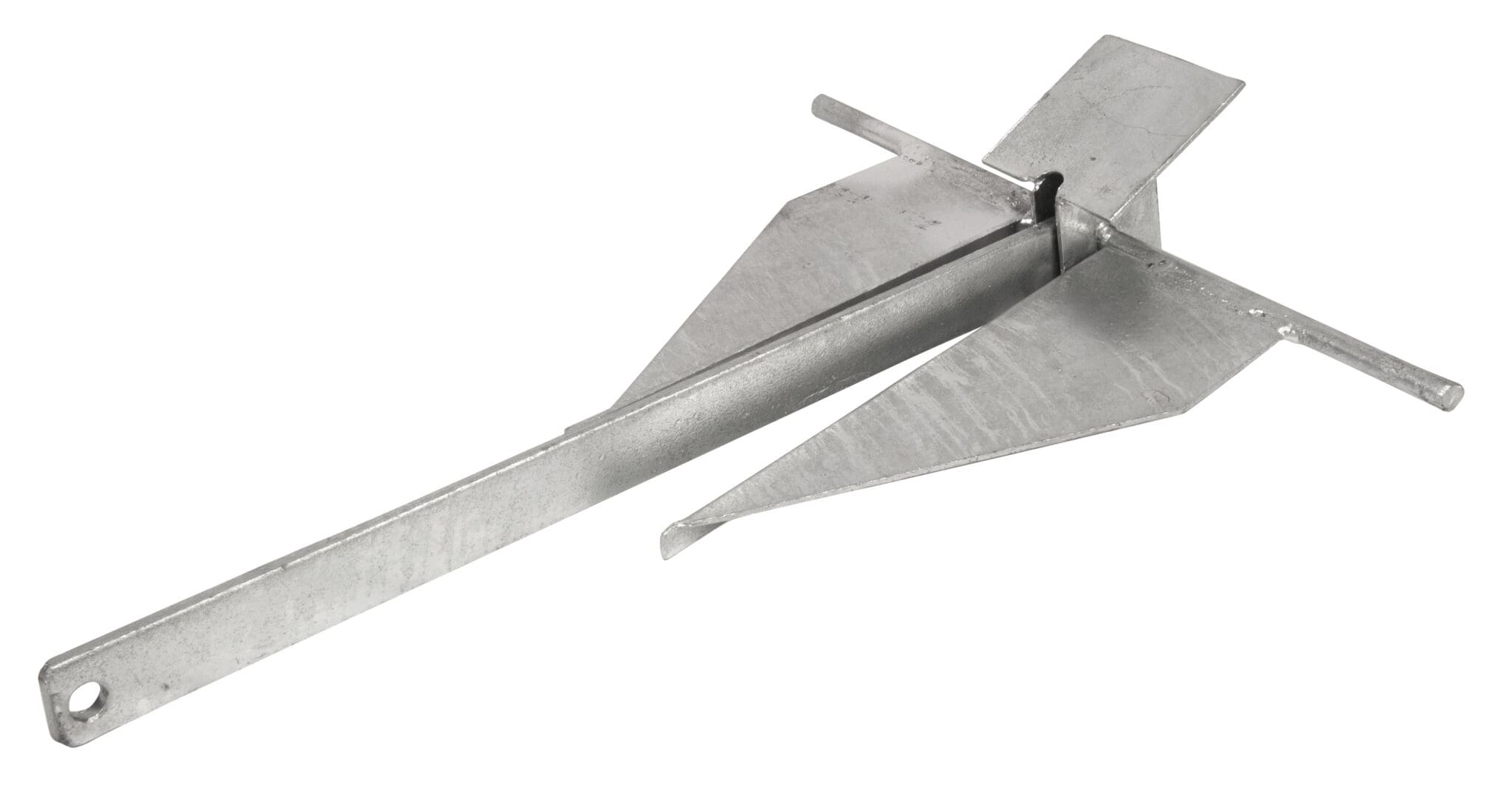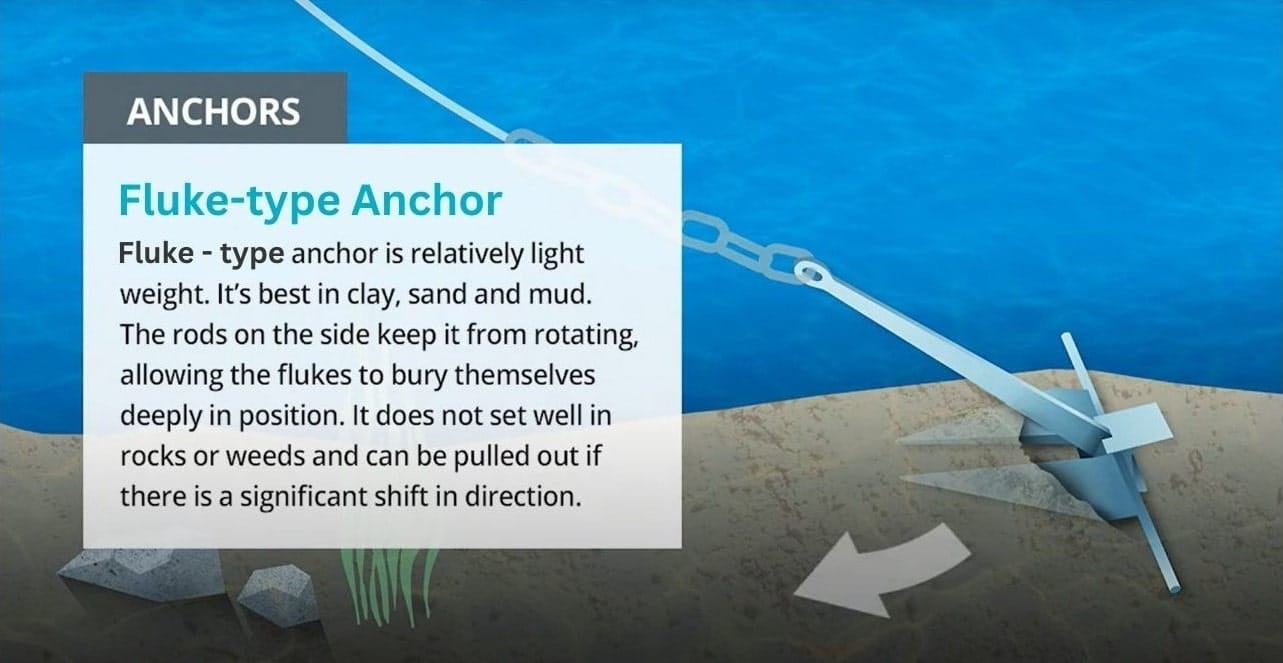Fluke Anchor
A fluke anchor is a popular choice among boaters due to its excellent holding power and lightweight design. Ideal for various seabed conditions, the fluke anchor provides a reliable anchoring solution for your vessel. This comprehensive guide will explain what a fluke anchor is, how to select the right one for your boat, best practices for its use, and details about different fluke anchor variations. Whether you’re an experienced sailor or new to boating, this information will help you make an informed decision when purchasing a fluke anchor.

What Is a Fluke Anchor?
A fluke anchor, also known as a Danforth anchor, features two large flat surfaces called flukes that dig into the seabed to hold your boat securely. The anchor has a stock at the crown—the opposite end of the shank—which helps the flukes orient downward into the seabed when tension is applied to the anchor line. This design allows for efficient penetration into soft seabeds like sand and mud, providing strong holding power relative to its weight.
The fluke anchor’s lightweight construction is typically made from high-strength materials such as galvanized steel or aluminum. This not only makes it easy to handle but also facilitates convenient storage due to its flat design. Its versatility in different anchoring conditions and cost-effectiveness make it a favored option among many boating enthusiasts.
However, it’s important to note that fluke anchors are less effective in rocky, weedy, or hard clay bottoms. They may also face challenges setting properly if not deployed correctly. Understanding these limitations will help you use the anchor more effectively and choose the right type for your needs.

How to Select the Right Fluke Anchor
Choosing the appropriate fluke anchor for your vessel involves considering several key factors, including your boat’s specifications and the typical anchoring conditions you encounter.
Determine Your Boat’s Specifications
The first step is to know your boat’s size and weight. Measure the Length Overall (LOA), which is the total length of your boat from the bow to the stern. Additionally, be aware of your vessel’s weight, including any gear and passengers, as this affects the anchor’s required holding power.
Consider Anchoring Conditions
Assess the environments where you typically anchor. This type of anchor performs best in soft seabeds like sand and mud. If you often anchor in areas with strong winds or currents, you may need a larger anchor to ensure adequate holding power. Water depth is another crucial factor; deeper waters may require more anchor line and potentially a heavier anchor to maintain the proper scope ratio.
Use Manufacturer Guidelines
Most anchor manufacturers provide recommendations and sizing charts that match anchor sizes to boat lengths and weights. Refer to these guidelines to select an anchor that suits your specific needs.
General Fluke Anchor Sizing Chart:
| Boat Length | Anchor Weight (Galvanized) | Anchor Weight (Aluminum) |
|---|---|---|
| Up to 16 ft (4.9 m) | 4 lb (1.8 kg) | 2.5 lb (1.1 kg) |
| 17 – 23 ft (5.2 – 7 m) | 8 lb (3.6 kg) | 5 lb (2.3 kg) |
| 24 – 30 ft (7.3 – 9.1 m) | 13 lb (5.9 kg) | 7 lb (3.2 kg) |
| 31 – 38 ft (9.4 – 11.6 m) | 16 lb (7.3 kg) | 10 lb (4.5 kg) |
| 39 – 45 ft (11.9 – 13.7 m) | 22 lb (10 kg) | 12 lb (5.4 kg) |
Note: These are general guidelines. Always consult the manufacturer’s specifications for accurate sizing.
Choose Between Galvanized Steel and Aluminum Fluke Anchors
When selecting a fluke anchor, you’ll often have a choice between galvanized steel and aluminum models. Galvanized steel anchors are durable and more affordable, but they are heavier, which may require more effort to handle. Aluminum ones are lightweight and easier to manage, especially on smaller boats, but they are typically more expensive and may not be as durable in abrasive conditions.
Consider a Fluke Anchor Kit
A fluke anchor kit can be a convenient option, especially for those new to boating or looking for an all-in-one solution. These kits typically include the anchor, a length of galvanized chain, anchor rope (rode), and necessary hardware like shackles and swivels. Some kits may also come with a storage bag. Using a kit ensures that all components are appropriately sized and compatible, simplifying the setup process and often offering cost savings compared to purchasing each item separately.
Best Practices for Using a Fluke Anchor
To get the most out of your fluke anchor, it’s important to follow best practices in deployment, retrieval, and maintenance.
Proper Deployment of a Fluke Anchor
Before deploying the anchor, assess the anchoring area to ensure the seabed is suitable—preferably sand or mud. Attach the anchor line and chain securely to the anchor, checking all connections for wear or damage. Determining the correct scope is crucial; aim for a 7:1 ratio, meaning seven feet of anchor line for every foot of water depth plus the distance from the waterline to where the anchor line is secured on your boat (freeboard). For comprehensive safety guidelines related to anchoring and boating practices, refer to the U.S. Coast Guard Boating Safety Circulars.
Lower the anchor slowly into the water until it reaches the seabed, avoiding throwing it, which can cause tangles. Once the anchor is on the bottom, gently reverse the boat to lay out the line and help the flukes dig into the seabed. Apply tension to the anchor line to set the anchor firmly. Verify that the anchor is holding by checking fixed points on shore or using electronic equipment like a GPS to ensure you’re not drifting.
Retrieving the Fluke Anchor
When it’s time to retrieve the anchor, approach it slowly to reduce tension on the line. Pull the anchor line vertically to lift the anchor out of the seabed. Avoid dragging it along the bottom, as this can damage both the anchor and the marine environment.
Maintenance Tips
Regular inspection and maintenance of your anchor will extend its lifespan and ensure reliability. After each use, especially in saltwater, rinse the anchor with fresh water to remove any corrosive elements. Check for signs of corrosion, bent flukes, or damaged parts, and address any issues promptly. Store the anchor securely to prevent it from moving while the boat is underway, which could cause injury or damage.
Fluke Anchor Variations and Details
Understanding the different variations of fluke anchors can help you choose the best one for your boating needs.
Standard Fluke Anchor
The standard anchor has two symmetrical flukes attached to a shank with a stock at the crown. It’s commonly made of galvanized steel and is suitable for general-purpose anchoring in soft seabeds. Its design offers a balance between holding power and ease of handling, making it a popular choice for many boaters.
High-Holding Fluke Anchor
For areas with strong currents or winds, a high-holding fluke anchor may be more appropriate. These anchors feature larger flukes and sharper angles, enhancing their ability to penetrate the seabed and providing greater holding power. While they may be slightly heavier or bulkier, the added security can be valuable in challenging conditions.
Lightweight Aluminum Anchor
Due to their reduced weight, lightweight aluminum fluke anchors are easier to handle, which can be especially beneficial on smaller boats or for individuals who may have difficulty lifting heavier anchors. However, they may require a larger size to match the holding power of their steel counterparts and may not be as durable in abrasive or rocky conditions.
Fluke Anchor Kits
Fluke anchor kits offer convenience and value by bundling the anchor with other essential components. A typical kit includes the fluke anchor, about 6 feet (1.8 meters) of galvanized chain, 100 feet (30 meters) of nylon anchor rope, and the necessary hardware like shackles and swivels. Some kits also come with a storage bag for easy transport and organization. These kits ensure that all parts are compatible and appropriately sized, simplifying the anchoring process.
Valuable Facts and Data About Fluke Anchors
Understanding your anchor’s capabilities and limitations can enhance safety and performance. Under optimal conditions, a fluke anchor can hold from 10 to 20 times its weight, making it highly efficient. Effective penetration into the seabed is crucial for holding power. A properly set anchor will penetrate into the seabed to a depth approximately equal to the length of its flukes, ensuring optimal holding strength.
The scope—the ratio of anchor line length to water depth plus freeboard—is critical for maximizing holding power. Increasing the scope significantly improves the anchor’s effectiveness. For example, moving from a 5:1 to a 7:1 scope ratio can greatly enhance holding capacity.
Holding Power Estimates
| Anchor Weight | Soft Mud Holding (lbs) | Sand Holding (lbs) |
|---|---|---|
| 8 lb (3.6 kg) | Up to 800 lbs | Up to 1,600 lbs |
| 13 lb (5.9 kg) | Up to 1,300 lbs | Up to 2,600 lbs |
| 16 lb (7.3 kg) | Up to 1,600 lbs | Up to 3,200 lbs |
Note: Actual holding power varies based on seabed conditions and proper anchor setting.
Calculating the Scope for Your Fluke Anchor
Proper scope is essential for anchor performance. The scope ratio is calculated using the formula:
Example Calculation:
- Water Depth: 15 ft (4.6 m)
- Freeboard: 3 ft (0.9 m)
- Desired Scope Ratio: 7:1
Calculate Anchor Rode Length:
Length=7×(15+3)=7×18=126 ft (38.4 m)
By ensuring you have enough anchor line out, you improve the anchor’s holding power and reduce the risk of dragging.
A fluke anchor is an excellent choice for boaters seeking a reliable and lightweight anchoring solution, particularly in soft seabed conditions like sand and mud. By selecting the appropriate fluke anchor for your vessel, considering factors such as boat size, weight, and typical anchoring conditions, you enhance your safety and confidence on the water.
Following best practices in deployment, retrieval, and maintenance ensures that your anchor performs effectively when you need it most. Whether you opt for a standard fluke anchor or a complete fluke anchor kit, investing in quality equipment tailored to your needs will provide peace of mind during your boating adventures.
FAQ section
How to set a fluke anchor?
How does a fluke-style anchor hold a boat in place?
What is the angle of a fluke anchor?
What is the difference between a fluke anchor and a plow anchor?
What kind of terrain are fluke anchors most used for?
Are fluke anchors good?
Does a fluke anchor need a chain?
How do you pull up a fluke anchor?
What is another name for a fluke anchor?
A fluke anchor is also commonly referred to as a Danforth anchor, named after its original designer.